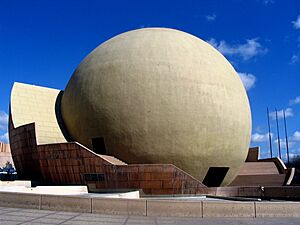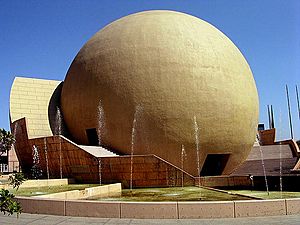Tijuana Cultural Center facts for kids
| Centro Cultural Tijuana | |
 |
|
| Established | 20 October 1982 |
|---|---|
| Location | Tijuana, Mexico |
| Type | Cultural center |
| Collections | Museo de las Californias |
The Tijuana Cultural Center (also known as CECUT) is a special place in Tijuana, Mexico. It's located in the Zona Río area. This center opened on October 20, 1982. Every year, more than a million people visit CECUT.
CECUT offers many fun and educational programs. There are classes for very young children. Older kids can join art and craft workshops. The center also hosts concerts, talks, movies, and exhibitions. It's a great place for people of all ages to learn and have fun.
Contents
What to See and Do at CECUT
CECUT has many exciting attractions and facilities. It's designed to offer something for everyone.
The OMNIMAX Cinema: "The Ball"
The most famous part of CECUT is its OMNIMAX cinema. Architects Pedro Ramirez Vazques and Manuel Rossen Morrison designed it. It's the only IMAX cinema in Tijuana. People often call it La Bola, which means "The Ball". This is because of its round shape.
The cinema has a special projector. It shows movies on a huge dome screen. This makes you feel like you are right inside the film! The cinema can seat 308 people.
The OMNIMAX cinema has been open since 1982. Its first movie was El pueblo del sol. This film showed beautiful parts of Mexico. It was very popular for many years. Today, the cinema shows different films every day. About four new films are shown each year.
Outdoor Spaces and Shops
CECUT has a large open area called an esplanade. It can hold up to 6,000 people. This space is used for concerts, festivals, and big shows. It's a lively spot where many events happen.
There is also a large bookshop at CECUT. You can find books there, along with cool handicrafts. They also sell unique design items.
Museums and Gardens
The center has a permanent exhibition called the Museo de las Californias. This museum shows the history of the Baja Peninsula. It also covers the history of California in the U.S. There are over 200 items on display. They show life from ancient times up to the early 1900s.
Outside, you can explore the Jardin Caracol, or "Snail Garden". This garden has sculptures inspired by ancient Mexican cultures. These cultures lived in southern Mexico long ago. You can also find a small café in the garden. It's a nice place to relax.
The Theatre and El Cubo
CECUT has a theatre that can hold about a thousand people. It's often used for private concerts and plays. There are also rooms for lectures and a video room.
In September 2008, CECUT opened a new building called El Cubo. This means "The Cube". It got its name because it's a square building. This is a big contrast to "The Ball" cinema. El Cubo hosts special art exhibitions from around the world. Past exhibits have featured works from famous artists and different countries.
You can also find the Cubo Bistro restaurant here. It serves French food. A famous chef named Javier Plascencia helps run it. He is known for his "Baja Med" style of cooking.
History of CECUT
The Tijuana Cultural Center opened in 1982. Its main goal was to encourage people from the U.S. to visit Tijuana for cultural events. The famous architects Pedro Ramírez Vázquez and Manuel Rosen Morrison designed the building.
When it first opened, CECUT was part of a national fund for social activities. Later, it became part of different government ministries. In 1986, CECUT became independent. This meant it could plan its own activities and manage its own money. Since then, it has focused on promoting culture for everyone.
CECUT is easy to reach. It's about a 2.1 kilometer walk from the San Ysidro border crossing into Mexico.
External links
- Official Website: http://www.cecut.gob.mx/



